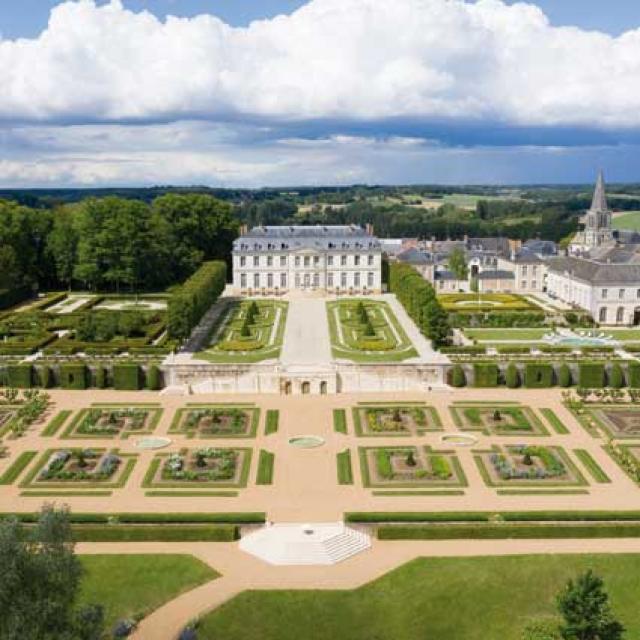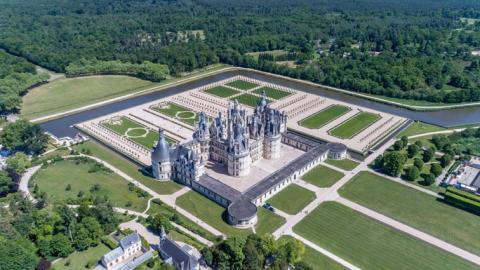The château de Grand-Luce, to the south of Le Mans in the Sarthe region, is only 55 minutes by train from the centre of Paris. It is one of the most magnificent examples of 18th Century neoclassical French architecture and landscape gardening, not only in the Loire valley but in the whole of France. This beautiful limestone structure built in 1889 on the site of an ancient medieval château was in need of significant restoration. The American Marcy Holthus has been the new owner of the château du Grand Luce since 2017. She lives in the south of California in the coastal town of La Jolla, a district of San Diego, situated at around two hours south of Los Angeles. She is a real estate investor with a particular interest in important historical and archaeological properties. This hotel has become a jewel of the luxury hotel industry.

The gardens
The Grand-Lucé estate is one of the largest estates in the Loire Region. The 30-hectare park consists of French-style gardens, an exotic garden, vegetable garden, forest, pond and meadow.
Surrounded by a medieval wall, the lawns and private gardens of the château du grand-luce lead the guests into a veritable kingdom in the north of the Loire valley. The château gardens, true to the classical French style, were inspired by the gardens of Versailles: designed around a north-south axis, the French-style gardens are located closest to the château, while the lawns/grounds become progressively less structured near the woods.
The classic gardens are a brilliant feat of order and symmetry with a near perfect structure. The central alley, finely manicured boxwoods, delightful topiaries and immaculately trimmed expanses of lawn are really quite extraordinary.
At a slightly lower elevation, and surrounded by walls protecting the area from the wind, is the Exotic Garden. This extravagant garden remains incredibly warm, benefitting most from the Loire Valley sunshine. The exotic garden has a remarkable array of flowers and a stunning swimming pool. It adjoins the original greenhouses, which are still in operation, and the orangery — becoming a space with infinite possibilities during the warmer months.
Below the parterre of the classic gardens is a superb kitchen garden and orchard providing an abundance of the fruits and vegetables grown in the Loire Valley – green beans, many varieties of tomatoes, lettuces, artichokes, fine herbs, lavender, small fruits, apples and pears.
Beyond the kitchen garden, there are many hectares (acres) of woodland to explore - a lake, meadows, grasslands and a historic white oak forest with a circular clearing in the centre (as designed in 1760). The pièce de résistance is found in this clearing — a statue of Zeus, one of eight statues placed throughout the grounds by King Louis XV as a gift to Baron Jacques Pineau de Viennay.
THE INSTALLATION OF A ZONE BY ZONE IRRIGATION SYSTEM
The French-style gardens. Located in the immediate vicinity of the château, clumps of hand-clipped boxwood hedges have been planted among the lawn areas, all surrounded by gravel paths. The irrigation system used on the French-style gardens has already been in place for several years. Only the controller has had to be changed and connected to a central control system, which we will describe later. The French-style gardens are currently irrigated with mid-range Rain Bird 5004 sprinklers facing each other and in the corners and at the ends. In the interior, full circle sprinklers have also been laid out. In total, there are a little over 170 sprinklers for irrigating the French-style formal gardens alone.
The water comes from a 60-metre deep borehole, with pumping and filtration. There is a small amount of silt present. The buffer storage tank allows for the silt to settle at the bottom of the tank. A pumping system then recovers the water from these tanks and sends it into the irrigation system.
The greenhouses and the fountain area. The very beautiful classic greenhouses built of iron and glass are attached to a wall, forming a half-tunnel. Annuals and biennials are grown there for the park’s floral displays. These plants are irrigated with an overhead drip system. This irrigation system produced by the consumer brand Teco already existed and does not form a part of the renovation work.
The tree-lined gardens and fruit and vegetable plots. This area consists of clumps or banks of hedging surrounded by straight strips of lawn. Within the shrubbery area legumes, aromatic herbs and flowers are grown. For a number of years, the whole estate has been irrigated with a Rain Bird drip irrigation system and start-up kits with on/off control components, filter and pressure regulator (three in one).
The vegetables and aromatic herbs go directly to the restaurant and the flowers are used for decoration. This garden has always existed, but it has experienced periods of relative prosperity. The present owners have provided all the financial means to ensure that the areas that have flower beds have all the necessary plants. And the result is absolutely magnificent, particularly in the month of April.
Grass borders of 1.20 m surround the flower beds. They had not been irrigated up to now. 500 spray heads with rectangular nozzles are going to be installed on the site, as well as 26 solenoid valves and an ESP-LXME controller. The controller will schedule the irrigation for all the gardens situated on the lower terrace (vegetable garden and borders), all linked to a Rain Bird IQ central control system which will manage the irrigation process.
On the upper section (French-style garden), the old controller is going to be replaced and a second communication cartridge will link the upper part to the central control system.
WHY HAVE CENTRAL CONTROL OF THE IRRIGATION SYSTEM?
Reducing consumption is the main motivation for this investment. In fact, within the context of environmental preservation policies introduced for green spaces, the challenge was to reduce the consumption of water used for irrigation.
The system in place did not allow for the irrigation system to be monitored correctly, so it was replaced. The ideal tool was central control. This software enabled the 7 gardeners responsible for park maintenance and monitoring the irrigation to adjust the irrigation run time according to the weather conditions; to be responsive in the event of a breakdown or breakage and to apply the correct amounts of water to each green space.
INVENTARY OF THE EQUIPMENT
• 496 1804 spray heads
• 130 R-VAN LCS nozzles
• 134 R-VAN RCS nozzles
• 232 R-VAN SST nozzles
• 18 5004+ rotor sprinklers
• 18 Arroseurs 5004+
• 1 km of stranded cable
• 32 7’’ circular valve boxes
• 4 circular 10 » valve boxes
• 11 rectangular valve boxes
• 2 rain gauges
• 1 IQ CLOUD central control software freely accessible on the Internet 1IQ CLOUD
• 2ESP-LXME: IQ™ Satellite Controllers and Accessories
• 4 12-station extension modules for ESP-LXM
• 2 flow rate management modules for ESP-LXME controller
• 2 IQ-3G NCC network communication cartridges (cellular)
• 2 external antennas for IQ3G1Y with 90 cm of cable
• 2 Tee-type PVC flow-rate sensors on

